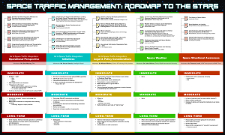Presentation Type
Paper (supporting PowerPoints may be added as Additional Files)
Location
Bass Auditorium
Start Date
26-2-2019 3:45 PM
Abstract
An important activity within Space Traffic Management is the detection and prevention of possible on-orbit collisions between space objects. The principal parameter for assessing collision likelihood is the probability of collision, which is widely accepted among conjunction assessment practitioners; but it possesses a known deficiency in that it can produce a false sense of safety when the orbital position uncertainties for the conjuncting objects are high. The probability of collision is said to be “diluted” in such a situation and to understate the possible risk; certain approaches have been recommended by researchers to provide (largely conservative) risk estimates and remediation methodologies in these cases. The present analysis explores two of the main proposals for quantifying and remediating possible risk in the dilution region and quantifies their operational implications. These implications with regard to imputed additional workload are considerable, especially in anticipating the conjunction event levels expected with the deployment of the USAF Space Fence radar. This effort has been undertaken as part of a larger enterprise that seeks to clarify the philosophical and statistical underpinnings of the conjunction risk assessment process. The analysis presented herein argues that a form of hypothesis testing is implicitly used in conjunction assessment risk analysis, and that there are a number of conceptual and practical reasons for constructing the associated null hypothesis to counsel against a satellite conjunction remediation action. In short, it is concluded that, for the purposes of determining whether a conjunction remediation action should be pursued, dilution-region probabilities of collision should be treated no differently from those produced under other circumstances.
Area of Interest
Space Situational Awareness
Biographies
Satellite Conjunction Assessment Risk Analysis for “Dilution Region” Events: Issues and Operational Approaches
Bass Auditorium
An important activity within Space Traffic Management is the detection and prevention of possible on-orbit collisions between space objects. The principal parameter for assessing collision likelihood is the probability of collision, which is widely accepted among conjunction assessment practitioners; but it possesses a known deficiency in that it can produce a false sense of safety when the orbital position uncertainties for the conjuncting objects are high. The probability of collision is said to be “diluted” in such a situation and to understate the possible risk; certain approaches have been recommended by researchers to provide (largely conservative) risk estimates and remediation methodologies in these cases. The present analysis explores two of the main proposals for quantifying and remediating possible risk in the dilution region and quantifies their operational implications. These implications with regard to imputed additional workload are considerable, especially in anticipating the conjunction event levels expected with the deployment of the USAF Space Fence radar. This effort has been undertaken as part of a larger enterprise that seeks to clarify the philosophical and statistical underpinnings of the conjunction risk assessment process. The analysis presented herein argues that a form of hypothesis testing is implicitly used in conjunction assessment risk analysis, and that there are a number of conceptual and practical reasons for constructing the associated null hypothesis to counsel against a satellite conjunction remediation action. In short, it is concluded that, for the purposes of determining whether a conjunction remediation action should be pursued, dilution-region probabilities of collision should be treated no differently from those produced under other circumstances.




Comments
Visit the Orbital Coordination: Part 2 session